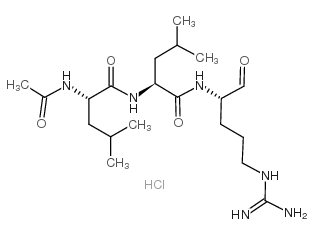Leupeptin hydrochloride

Leupeptin hydrochloride structure
|
Common Name | Leupeptin hydrochloride | ||
|---|---|---|---|---|
| CAS Number | 24125-16-4 | Molecular Weight | 463.01400 | |
| Density | N/A | Boiling Point | 734.4ºC at 760 mmHg | |
| Molecular Formula | C20H39ClN6O4 | Melting Point | N/A | |
| MSDS | USA | Flash Point | 398ºC | |
|
A versatile snap chip for high-density sub-nanoliter chip-to-chip reagent transfer.
Sci. Rep. 5 , 11688, (2015) The coordinated delivery of minute amounts of different reagents is important for microfluidics and microarrays, but is dependent on advanced equipment such as microarrayers. Previously, we developed the snap chip for the direct transfer of reagents, thus rea... |
|
|
PAWR-mediated suppression of BCL2 promotes switching of 3-azido withaferin A (3-AWA)-induced autophagy to apoptosis in prostate cancer cells.
Autophagy 11(2) , 314-31, (2015) An active medicinal component of plant origin with an ability to overcome autophagy by inducing apoptosis should be considered a therapeutically active lead pharmacophore to control malignancies. In this report, we studied the effect of concentration-dependen... |
|
|
RaPID: an aptamer-based mRNA affinity purification technique for the identification of RNA and protein factors present in ribonucleoprotein complexes.
Methods Mol. Biol. 714 , 387-406, (2011) RNA metabolism involves regulatory processes, such as transcription, splicing, nuclear export, transport and localization, association with sites of RNA modification, silencing and decay, and necessitates a wide variety of diverse RNA-interacting proteins. Th... |
|
|
SIRT5 regulation of ammonia-induced autophagy and mitophagy.
Autophagy 11(2) , 253-70, (2015) In liver the mitochondrial sirtuin, SIRT5, controls ammonia detoxification by regulating CPS1, the first enzyme of the urea cycle. However, while SIRT5 is ubiquitously expressed, urea cycle and CPS1 are only present in the liver and, to a minor extent, in the... |
|
|
Current methods in investigating the development of the female reproductive system.
Methods Mol. Biol. 550 , 137-57, (2009) The female reproductive system is important as the site for development and fertilization of an oocyte, for implantation and development of an embryo, and for growth and delivery of the fetus. It also produces protein and steroid hormones that help maintain a... |
|
|
Urinary proteases degrade albumin: implications for measurement of albuminuria in stored samples.
Ann. Clin. Biochem. 47 , 151-7, (2010) Previous studies have shown that albumin in stored urine samples degrades over time, and that albumin losses are greatest in samples with low pH conditions (pH < 5). Furthermore, the high-performance liquid chromatography (HPLC) assay for urinary albumin has ... |
|
|
Novel P2Y12 adenosine diphosphate receptor antagonists for inhibition of platelet aggregation (I): in vitro effects on platelets.
Thromb. Res. 122 , 523-32, (2008) ADP plays a key role in platelet aggregation which has led to the development of antiplatelet drugs that target the P2Y12 receptor. The aim of this study was to characterize the effects of two novel P2Y12 receptor antagonists, BX 667 and its active metabolite... |
|
|
Comparative response of rat and rabbit conceptuses in vitro to inhibitors of histiotrophic nutrition.
Birth Defects Res. B Dev. Reprod. Toxicol. 104(1) , 1-10, (2015) Histiotrophic nutrition via the visceral yolk sac is an essential nutritional pathway of the rodent conceptus, and inhibition of this pathway may cause growth retardation, malformations, and death in rodent embryos. Morphologic differences among species durin... |
|
|
Pharmacologic inhibition of site 1 protease activity inhibits sterol regulatory element-binding protein processing and reduces lipogenic enzyme gene expression and lipid synthesis in cultured cells and experimental animals. Hawkins, J.L., et al.
J. Nutr. 326 , 801-8, (2008)
|